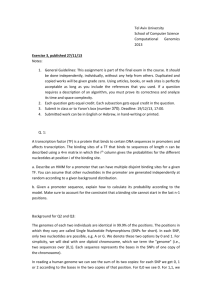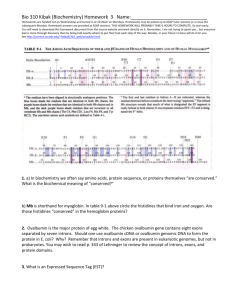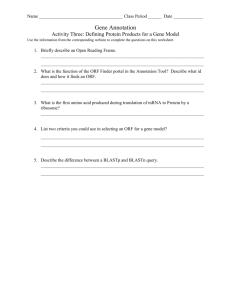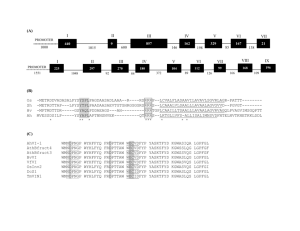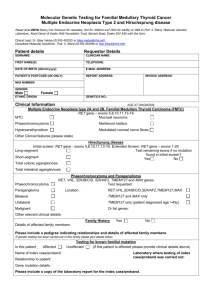Christine Holleman – Alu elements
advertisement
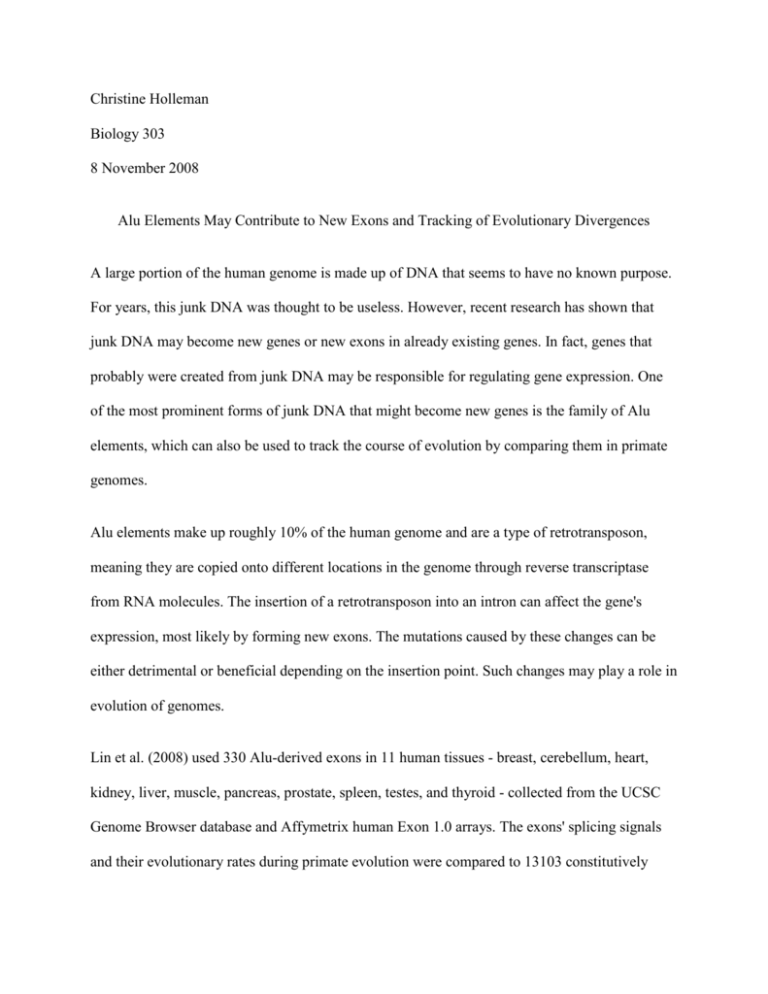
Christine Holleman Biology 303 8 November 2008 Alu Elements May Contribute to New Exons and Tracking of Evolutionary Divergences A large portion of the human genome is made up of DNA that seems to have no known purpose. For years, this junk DNA was thought to be useless. However, recent research has shown that junk DNA may become new genes or new exons in already existing genes. In fact, genes that probably were created from junk DNA may be responsible for regulating gene expression. One of the most prominent forms of junk DNA that might become new genes is the family of Alu elements, which can also be used to track the course of evolution by comparing them in primate genomes. Alu elements make up roughly 10% of the human genome and are a type of retrotransposon, meaning they are copied onto different locations in the genome through reverse transcriptase from RNA molecules. The insertion of a retrotransposon into an intron can affect the gene's expression, most likely by forming new exons. The mutations caused by these changes can be either detrimental or beneficial depending on the insertion point. Such changes may play a role in evolution of genomes. Lin et al. (2008) used 330 Alu-derived exons in 11 human tissues - breast, cerebellum, heart, kidney, liver, muscle, pancreas, prostate, spleen, testes, and thyroid - collected from the UCSC Genome Browser database and Affymetrix human Exon 1.0 arrays. The exons' splicing signals and their evolutionary rates during primate evolution were compared to 13103 constitutively spliced exons and 5389 exon-skipping cassette exons in the human genome collected from the Alternative Splicing Annotation Project 2 database. The results showed that Alu-derived exons had weaker splicing signals than the other two types of exons. The median 5' splice site score was 7.35 for Alu-derived exons, 8.27 for cassette exons, and 8.88 for constitutive exons. The median 3' splice site score was 6.79 for Alu-derived exons, 7.86 for cassette exons, and 8.87 for constitutive exons. Also, Alu-derived exons had an exonic splicing regulatory element density of 0.484, cassette exons had a density of 0.500, and constitutive exons had a density of 0.532. This trend was also noted in another trial done by Fairbrother et al. (2002) where the average density of Alu-derived exons was 0.144, the density of cassette exons was 0.268, and the density of constitutive exons was 0.328. Alu-derived exons are less likely to be spliced into mRNA because the majority is in an intermediate form. These exons are more likely to be spliced when they evolve and serve some sort of purpose. When the Alu-derived exons are spliced, it can be hard to predict how they will be spliced. Lin et al. (2008) showed the Alu-derived exons had very diverse splicing patterns. Some included in all or most tissues, and some were specific to a single type of tissue, such as the SEPN1 gene, which contains an Alu-derived exon. The selenoprotein produced by the SEPN1 gene is thought to be responsible for preventing oxidant damage. Mutations of the gene causing a type of muscular dystrophy support this theory (Moghadaszadeh et al. 2001). The Alu-derived exon had an increased level in muscle tissue, suggesting an alternative splicing pattern for the exon. Such a splicing pattern seems to indicate that the exon is expressed only in certain tissues. The SEPN1 gene differs in other primate genomes when compared to RT-PCR analyses of the corresponding gene in other primates. Macaque muscle tissue did not have any of the Alu exon. Chimpanzee muscle tissue had some of the exon, but the levels were much lower than those found in humans. This result suggests that the exon was first included after the evolutionary divergence of chimpanzees and humans from each other. Interestingly, Gabriel et al. (2006) noted that transposable elements were more likely to arise during meiosis, and Lin et al. (2008) Alu-derived exons seem to become part of a gene more often during primate evolution. Lin et al. (2008) studied this latter phenomenon by analyzing the evolution of Alu-derived exons in chimpanzees, orangutan, macaque, and marmoset genomes compared to humans. The overall nucleotide substitution rate of exons present in both human and chimpanzee genomes was 1.34% for Alu-derived exons, 0.73% for cassette exons, and 0.52% for constitutive exons. The substitution rates between humans and orangutans were 3.69% for Alu-derived exons, 1.81% for cassette exons, and 1.31% for constitutive exons. The substitution rates between humans and the other two types of primates had similar values. These results indicate that the mutation rate twice as high in exons that were created from Alu elements than in the other two types of exons. It could be that the evolutionary process causes this increase in Alu-derived exons somehow. On the other hand, such high substitution rates may be a cause of the observed evolution. Normally, the rate that Alu-derived exons become part of genes is not enough to cause the changes necessary for speciation. Most Alu elements inserted into genomes are countered and deleted by Alu recombination-mediated deletion, abbreviated as ARMD. ARMD seems to be activated by a mismatch between chromatids during recombination in meiosis or by a recombination event between two elements that are located on the same chromosome. Han et al. (2007) aligned 1091 potential ARMD loci from the genomes of humans, chimpanzees, and macaques. They found 663 chimpanzee-specific ARMD loci and only 492 human-specific ARMD loci. In addition, the number of exons deleted in the chimpanzee genome was found to be twice the number that was deleted from the human genome. The number of ARMD events in the human genome is not enough to counteract the creation of Alu elements, so more Alu elements are constantly added into the genome resulting in a degree of instability. Although Alu elements are found exclusively in primates, all organisms contain some type of transposable element. Gabriel et al. (2006) described an additional use for transposable elements. Tagged transposons can be inserted into genomes and used to observe any phenotypic changes caused by the insertion into a particular gene, allowing the purpose of the gene to be observed. Of course, such a procedure could not be done with a human genome due to ethical reasons, but other species with genomes similar to a human's could be used. The procedure would become more complex as a genome became larger, but many genomes could be studied at once with the procedure. Alu elements are major contributors to the mutation rate of the human genome. These changes can create new genes or alter already existing genes, making new proteins that either help the organism or cause a genetic defect. If it were possible to control the creation of the elements and exons, it could be possible to repair genes, cure genetic defects, and induce mutations for experimental purposes. Along with being useful in genetic studies, the Alu elements and exons can be used to study the evolutionary changes in primates. This type of analysis can also be applied to other types of similar elements across a wide spectrum of species, allowing scientists to see how different species are related and how they evolved from their ancestors. If it was possible to effectively use them for these purposes, the mysteries of the human genome and evolution could be unlocked and understood much more quickly. References 1. Fairbrother WG, Yeh RF, Sharp PA, Burge CB (2002) Predictive identification of exonic splicing enhancers in human genes. Science 297: 1007–1013. 2. Gabriel A, Dapprich J, Kunkel M, Gresham D, Pratt SC, et al. (2006) Global Mapping of Transposon Location. PLoS Genet 2(12): e212. doi:10.1371/journal.pgen.0020212. 3. Han K, Lee J, Meyer TJ, Wang J, Sen SK, et al. (2007) Alu Recombination-Mediated Structural Deletions in the Chimpanzee Genome. PLoS Genet 3(10): e184. doi:10.1371/journal.pgen.0030184. 4. Lin L, Shen S, Tye A, Cai JJ, Jiang P, et al. (2008) Diverse Splicing Patterns of Exonized Alu Elements in Human Tissues. PLoS Genet 4(10): e1000225. doi:10.1371/journal.pgen.1000225. 5. Moghadaszadeh B, Petit N, Jaillard C, Brockington M, Roy SQ, et al. (2001) Mutations in SEPN1 cause congenital muscular dystrophy with spinal rigidity and restrictive respiratory syndrome. Nat Genet 29: 17–18.

